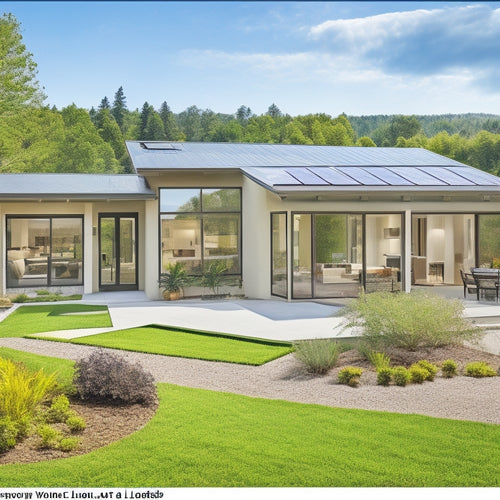
Best Solar Panel Options for Maximum Energy Efficiency
Share
You're looking for solar panels that can generate the most energy per hour of sunlight. Top-rated brands like SunPower, Panasonic, and Tesla lead the market, offering efficiency rates up to 22.8%. Efficient solar panel types, including monocrystalline, high-efficiency thin film, and bifacial panels, provide improved energy yields and reduced installation footprints. High-efficiency solar cells, advanced materials, and innovative designs further enhance performance. By exploring these options, you'll be well on your way to maximizing energy efficiency - and just around the corner, you'll find even more state-of-the-art solutions to take your energy production to the next level.
Key Takeaways
- Top-rated solar panel brands like SunPower, Panasonic, and Tesla offer high-efficiency rates, with SunPower's X-Series boasting a 22.8% efficiency rate.
- Monocrystalline Silicon Panels achieve efficiencies of 15%-20%, with higher energy conversion rates and excellent low-light performance.
- Bifacial Solar Technology generates up to 25% more energy than traditional monofacial panels, with improved durability and flexible placement options.
- High-Efficiency Thin Film is ideal for limited space applications, with higher energy yields per unit area and improved heat resistance.
- Advanced solar cells, such as perovskite cells and multi-junction cells, enhance cell performance and maximize power output.
Top-Rated Solar Panel Brands
Currently, the solar panel market is dominated by a handful of top-rated brands that have established themselves through exceptional product quality, innovative technology, and reliable performance.
You're likely to come across names like SunPower, Panasonic, and Tesla, which have consistently ranked high in brand comparisons. These top solar brands have managed to stay ahead of the competition by investing heavily in research and development, resulting in higher efficiency rates and improved durability.
When evaluating top solar brands, you should consider factors such as panel efficiency, warranty periods, and pricing.
For instance, SunPower's X-Series Residential Solar Panels boast an impressive 22.8% efficiency rate, while Panasonic's HIT-240 Series offers a 25-year warranty. Tesla's Solar Roof, on the other hand, combines sleek design with high-performance energy harvesting.
Efficient Solar Panel Types
You'll want to contemplate three efficient solar panel types that stand out for their performance: Monocrystalline Silicon Panels, High-Efficiency Thin Film, and Bifacial Solar Technology.
These options offer improved energy yields and reduced installation footprints compared to traditional solar panels.
Monocrystalline Silicon Panels
Among the most efficient solar panel types, monocrystalline silicon panels stand out for their exceptional performance and durability.
You'll appreciate their ability to generate maximum energy output while withstanding harsh environmental conditions.
Monocrystalline advantages are numerous, and you'll benefit from:
-
Higher energy conversion rates: Monocrystalline panels boast higher efficiencies, typically ranging from 15% to 20%, allowing you to generate more power per hour of sunlight.
-
Longer lifespan: With a monocrystalline lifespan of up to 30 years or more, you can rely on consistent energy production for decades to come.
-
Improved low-light performance: These panels excel in low-light conditions, ensuring you still generate power even on cloudy days.
- Enhanced durability: Monocrystalline panels are built to last, resisting corrosion and wear from extreme temperatures, humidity, and weather events.
When it comes to utilizing maximum energy efficiency, monocrystalline silicon panels are an excellent choice.
Their exceptional performance, durability, and low maintenance requirements make them an attractive option for those seeking reliable, long-term energy solutions.
High-Efficiency Thin Film
Three decades of research and development have refined High-Efficiency Thin Film (HETF) technology, yielding a class of efficient solar panel types that excel in specific applications.
You'll find HETF panels particularly suited for scenarios where space is limited, such as rooftops or building-integrated photovoltaics. Their slim profile and lower weight make them ideal for installations where structural integrity is a concern.
HETF technology boasts higher energy yields per unit area compared to traditional thin-film panels. This increased efficiency translates to a reduced environmental impact, as you'll require fewer panels to achieve the same energy output.
Additionally, HETF panels are more resistant to heat, ensuring consistent performance even in high-temperature application scenarios.
When evaluating HETF options, consider the specific requirements of your project. Look for panels with high power-per-unit-area ratings and low temperature coefficients for peak performance.
Bifacial Solar Technology
Bifacial solar panels, which can capture energy from both the front and back sides, have emerged as a highly efficient solar panel type, thanks to advancements in photovoltaic technology.
As you consider bifacial solar technology, you'll want to understand its advantages and applications. Here are some key benefits:
-
Increased energy yield: Bifacial panels can generate up to 25% more energy than traditional monofacial panels, making them ideal for large-scale solar farms.
-
Improved durability: The bifacial design allows for better heat dissipation, reducing the risk of thermal degradation and increasing the panel's lifespan.
-
Enhanced flexibility: Bifacial panels can be positioned on a variety of surfaces, including white roofs, sand, or water, making them suitable for diverse environments.
- Reduced costs: By increasing energy output, bifacial panels can reduce the levelized cost of electricity, making solar energy more competitive with fossil fuels.
When exploring bifacial applications, you'll find they're particularly suited for large-scale projects, such as utility-scale solar farms, agricultural installations, and building-integrated photovoltaics.
High-Efficiency Solar Cells
When you're looking for high-efficiency solar cells, you'll want to focus on cell efficiency enhancers that minimize energy losses and maximize power output.
These enhancers can include advanced materials, sophisticated design, and innovative manufacturing techniques.
Cell Efficiency Boosters
Your solar panel's energy harvesting capabilities hinge on the efficiency of its photovoltaic cells. However, even high-efficiency solar cells can be optimized further with cell efficiency enhancers. These innovative technologies improve energy production by minimizing losses and maximizing gains.
To take your solar panel's performance to the next level, consider the following cell efficiency enhancers:
-
Bifacial cells: These cells can absorb light from both the front and back sides, increasing energy output by up to 25%.
-
Perovskite cells: These cells have shown higher power conversion efficiency rates than traditional silicon-based cells, with potential gains of up to 10%.
-
Multi-junction cells: By stacking multiple layers of photovoltaic materials, these cells can capture energy from a wider range of sunlight, resulting in up to 15% more energy output.
- Thermophotonic cells: These cells convert heat into light, which is then absorbed by the photovoltaic material, increasing energy production by up to 20%.
Maximum Power Output
Regularly, solar panels with high-efficiency cells are the go-to choice for those seeking maximum power output. These cells are designed to convert sunlight into electricity at an exceptional rate, often exceeding 22% efficiency. You can expect to generate more power per hour of sunlight with high-efficiency solar panels, making them ideal for rooftops with limited space or for those who want to maximize their energy storage.
When selecting high-efficiency solar panels, consider the type of cells used. Monocrystalline silicon cells, for instance, offer higher efficiencies than polycrystalline cells. Additionally, look for panels with a low temperature coefficient, as this guarantees optimal performance even in high-temperature conditions.
Proper solar panel maintenance is also vital to maintain maximum power output. Regular cleaning and inspection can help prevent energy losses due to dirt and debris buildup.
High-efficiency solar panels can greatly impact your energy storage capabilities. With more power generated per unit area, you can store excess energy for later use, reducing your reliance on the grid.
Best Solar Panel Inverters
One essential component of a solar panel system is the inverter, which converts the DC power generated by the panels into AC power that can be fed into the grid or used to power electrical devices.
When selecting the best solar panel inverter for your system, you'll want to take into account the type of inverter and its efficiency.
There are several solar inverter types to choose from:
-
String inverters: These are the most common type, converting DC power from a string of panels into AC power.
-
Microinverters: These convert DC power from individual panels into AC power, providing more flexibility and monitoring capabilities.
-
Power optimizers: These systems use a combination of DC-DC converters and a central inverter to optimize energy harvest at the panel level.
- Hybrid inverters: These inverters combine the functions of a solar inverter and a battery inverter, allowing for energy storage and backup power.
When evaluating inverter efficiency, look for a high maximum efficiency rating (e.g., 98.5%) and a high CEC weighted efficiency rating (e.g., 97.5%).
Higher efficiency means more energy harvested and fed into the grid or used to power your devices.
Maximum Power Output Panels
What level of power output do you need from your solar panels? If you're looking to maximize energy production, you'll want to contemplate solar panels with high power output ratings. These panels are designed to optimize energy output, ensuring you get the most from your solar investment.
When it comes to maximum power output, you'll want to look for solar panels with high wattage ratings, typically above 400 watts. These high-performance panels employ advanced solar panel technology, such as bifacial cells, to increase energy output. Bifacial cells capture light from both the front and back sides of the panel, resulting in up to 25% more energy output.
To further optimize energy output, contemplate panels with advanced features like multi-busbar design, which reduces electrical losses and increases power output.
Additionally, look for panels with high fill factors, which indicate a panel's ability to convert sunlight into usable electricity efficiently. By choosing solar panels with high power output ratings and advanced features, you'll be able to maximize your energy production and get the most from your solar panel system.
Solar Panels for Home Use
Essential energy self-sufficiency begins at home, and selecting the right solar panels is essential to achieving this goal.
As you consider shifting to renewable energy, understanding your options is significant. For residential use, you'll want to focus on solar panels that provide maximum energy efficiency while being budget-friendly.
When choosing solar panels for your home, consider the following key factors:
-
Efficiency rating: Look for panels with high efficiency ratings (above 20%) to maximize energy production.
-
Durability: Confirm the panels are built to last, with a minimum 25-year warranty.
-
Cost: Investigate solar panel financing options and residential solar incentives to reduce upfront costs.
- Compatibility: Verify the panels are compatible with your existing electrical infrastructure.
Commercial Solar Panel Options
You'll want to contemplate high-efficiency panel options for your commercial solar installation, as they can maximize energy output and reduce the overall system size.
When evaluating installation methods, you'll need to weigh the costs and benefits of rooftop versus ground-mounted systems, as well as the potential for tracking systems to optimize energy production.
High-Efficiency Panel Options
Twenty-five percent of commercial solar installations opt for high-efficiency panel options, which are designed to maximize energy production in limited spaces.
As you evaluate your commercial solar panel options, you'll want to investigate high-efficiency panels that can help you generate more power while minimizing your environmental footprint.
Here are some key benefits to evaluate:
-
Higher energy output: High-efficiency panels can produce up to 20% more energy per hour than standard panels, making them ideal for commercial applications where energy demands are high.
-
Increased roof space utilization: By generating more energy per panel, you can maximize energy production even in limited roof spaces.
-
Advanced solar panel innovations: High-efficiency panels often incorporate state-of-the-art technologies, such as bifacial cells and PERC (Passivated Emitter and Rear Cell) technology, to enhance energy output.
- Improved energy storage solutions: High-efficiency panels can help you store excess energy generated during the day for use during peak hours or at night, reducing your reliance on the grid.
Cost-Effective Installation Methods
While high-efficiency panels can greatly enhance energy production, they often come at a premium cost. To maximize your return on investment, you'll want to evaluate cost-effective installation methods. One approach is to investigate DIY installation tips. By taking on some of the installation tasks yourself, you can reduce labor costs and allocate more resources to high-quality panels.
However, be sure to weigh the potential savings against the risks of improper installation, which can compromise system performance and longevity.
Alternatively, you can look into financing options that allow you to spread the cost of installation over time. Many commercial solar panel providers offer financing packages or power purchase agreements (PPAs) that can help you get started with little to no upfront capital.
These options can be particularly attractive for businesses or organizations with limited budgets. By carefully evaluating your installation options and financing strategies, you can optimize your solar panel system for maximum energy efficiency and cost savings.
Budget-Friendly Solar Panels
Investigate budget-friendly solar panels that can help you employ renewable energy without breaking the bank.
With the rising cost of traditional energy sources, it's crucial to examine affordable options that can provide significant energy savings.
When it comes to budget-friendly solar panels, you have several options to evaluate:
-
Polycrystalline Silicon Solar Panels: These panels are made from melted silicon and are a cost-effective alternative to monocrystalline silicon panels.
-
Thin-Film Solar Panels: These panels use a thin layer of photovoltaic material to convert sunlight into energy, making them a more affordable option.
-
Bifacial Solar Panels: These panels can capture energy from both the front and back sides, increasing energy output while reducing costs.
- Used or Refurbished Solar Panels: Think about purchasing used or refurbished solar panels that are still in good condition, offering a budget-friendly way to go solar.
Durable Solar Panel Materials
With the rise of renewable energy, selecting durable solar panel materials is essential to guarantee a long-lasting and efficient energy harvesting system.
You'll want materials that can withstand harsh environmental conditions, such as extreme temperatures, hail, and UV exposure. A durable solar panel material guarantees a longer solar panel lifespan, typically ranging from 25 to 30 years or more.
When evaluating materials, consider impact resistance, which is important for withstanding physical stress. Look for materials with high impact resistance ratings, such as tempered glass or high-strength polymers.
These materials can absorb and distribute impact forces, reducing the risk of cracks and breakages.
Additionally, consider the frame material, which provides structural support to the solar panel. Aluminum or anodized aluminum frames are popular choices due to their corrosion resistance, strength, and durability.
A well-designed frame can help extend the solar panel lifespan by protecting the internal components from environmental stressors.
Advanced Solar Panel Features
Beyond durability, advanced solar panel features further enhance the performance and efficiency of your renewable energy system.
These innovative features take your solar panel system to the next level, ensuring you maximize your energy output.
To get the most out of your solar panels, consider the following advanced features:
-
Solar tracking: This feature adjusts the angle and orientation of your solar panels to follow the sun's movement, increasing energy production by up to 45%.
-
Energy storage: Integrated energy storage systems allow you to store excess energy generated during the day for use during the night or on cloudy days, reducing your reliance on the grid.
-
Micro-inverters: These small inverters optimize energy production at the individual panel level, ensuring that each panel operates independently to maximize output.
- Advanced monitoring systems: Real-time monitoring and analytics help you track your energy production, identify potential issues, and optimize your system for peak performance.
Frequently Asked Questions
Can I Install Solar Panels on a Metal or Clay Tile Roof?
You can install solar panels on a metal or clay tile roof, but you'll need to take into account metal roof considerations, such as guaranteeing a watertight seal, and verify clay tile compatibility with your chosen mounting system to ascertain a secure fit.
Do Solar Panels Work Well in Shaded or Cloudy Areas?
You'll find that solar panels don't exactly thrive in shaded or cloudy areas, as their efficiency takes a hit; however, high-quality panels with optimized shaded performance and cloudy efficiency can still capture some power, albeit reduced.
Can I Add More Panels to My Existing Solar Panel System?
You can add more panels to your existing solar panel system, but verify solar panel compatibility and consider installation factors like roof space, wiring, and inverter capacity to optimize energy output and avoid system bottlenecks.
Will Solar Panels Increase My Property's Value?
You'll likely see an increase in property value, as a solar panel installation can elevate your property's appraisal by up to 17%, thanks to the attractive energy savings and reduced carbon footprint, making your home more desirable to potential buyers.
Are There Any Government Incentives for Solar Panel Installation?
You can capitalize on government incentives for solar panel installation, including federal tax credits, which cover up to 30% of total costs, and state rebates, varying by region, to greatly reduce your upfront investment.
Conclusion
Optimizing your solar panel system for maximum energy efficiency requires careful consideration of state-of-the-art components. By choosing top-tier brands, efficient panel types, high-performance cells, and advanced inverters, you'll utilize harvesting harmony. Pair these picks with maximum power output panels, durable materials, and innovative features, and your setup will shine with supreme collaboration.
Related Posts
-

Innovative Sustainable Materials for Energy-Efficient Homes
Innovative sustainable materials enable you to create energy-efficient homes while promoting environmental responsibi...
-

Integrating Smart Technology for Energy Savings
Integrating smart technology into your home is a transformative factor for energy savings. Smart thermostats give you...
-

Passive Solar Design Strategies for Homes
To effectively implement passive solar design strategies in your home, focus on ideal building orientation and strate...


